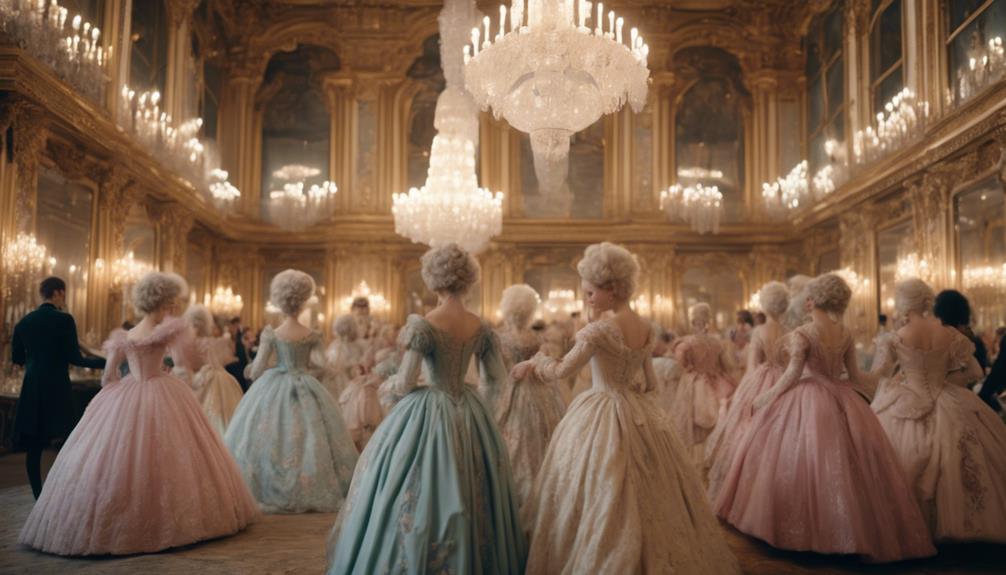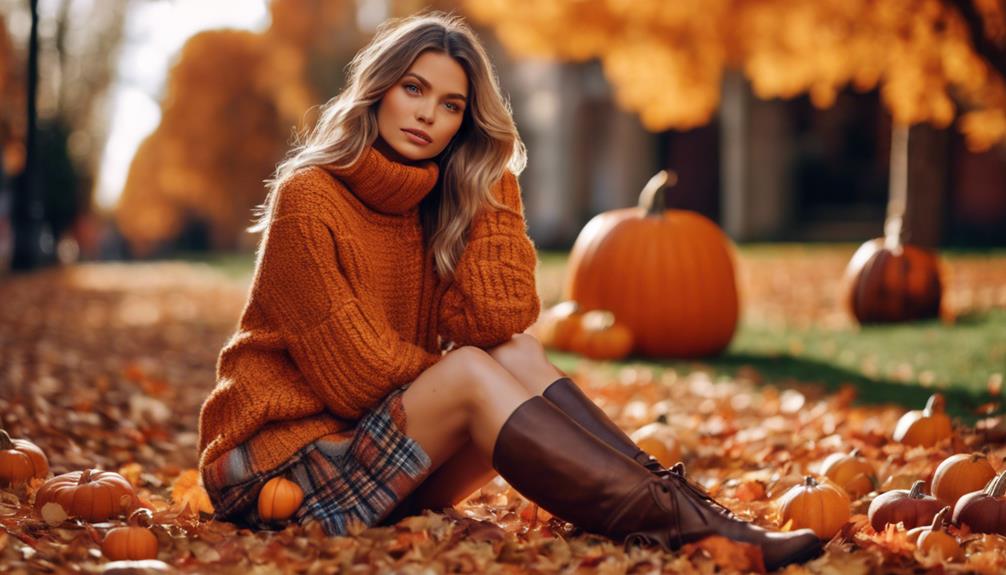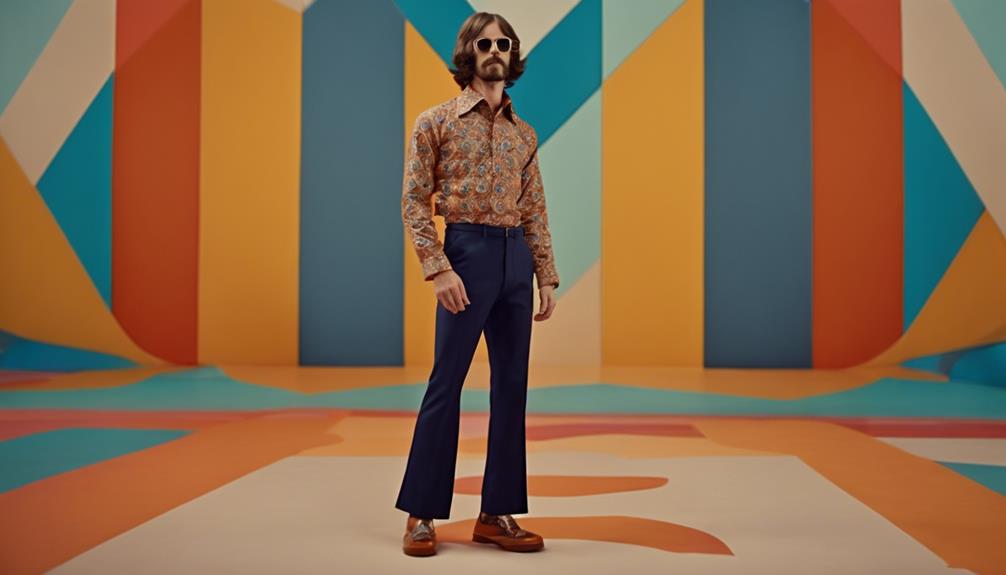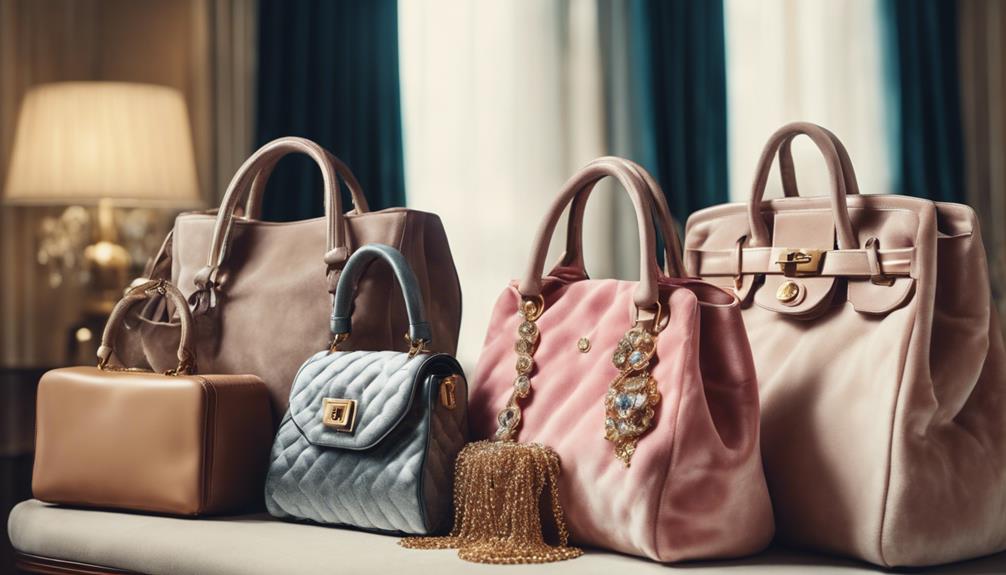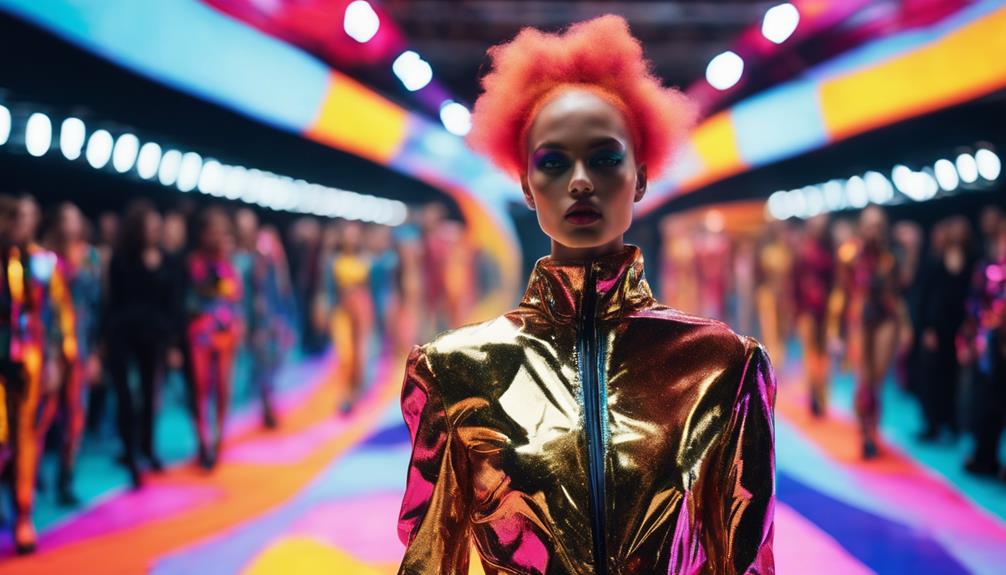If you are fascinated by fashion from the 17th century, you are in for a treat! This period featured luxurious silks, vibrant prints, and unique silhouettes that emphasized social status and creativity. You will find broad shoulders, cinched waists, and bold colors that represent wealth and artistic flair. Influential figures, such as royalty, established trends that continue to impact modern style today. Explore how these timeless looks can influence your wardrobe now. Additionally, discover trendy styling tips and sustainable practices to ensure these classic pieces remain relevant in your closet. Keep delving into the captivating journey of this intriguing fashion era!
Key Takeaways
- 17th-century fashion showcased opulence through luxurious silk fabrics and vibrant, intricate prints inspired by nature.
- Signature silhouettes included wide shoulders and fitted waists, emphasizing the hourglass figure that defined the era.
- Cultural icons of the time influenced societal fashion standards, establishing trends that resonate in modern styles.
- The Jacquard loom revolutionized textile production, making complex patterns in silk more accessible to a broader audience.
Origin and historical background of the fashion trend/style
When you explore the origins of 17th-century fashion, you'll notice how it transformed in response to social and cultural shifts.
Key figures and cultural icons influenced styles that showcased wealth and status, making fashion a powerful tool of expression.
Understanding these changes helps you appreciate the era's impact on modern trends.
Fashion's Transformative Journey
Evolving dramatically over the centuries, fashion reflects society's changing values, roles, and aspirations, with each era leaving a distinct mark on style and identity.
In the early 1900s, fashion trends emphasized an S-shape silhouette, showcasing a narrow waist and full skirts that mirrored contemporary ideals of femininity. As the 1910s approached, practicality took center stage. Designers like Paul Poiret challenged traditional norms, abandoning corsets and promoting natural silhouettes, aligning with women's evolving roles during World War I.
The 1920s, famously known as the Roaring Twenties, brought about the flapper look, featuring shorter hemlines and boyish silhouettes. This shift represented a newfound sense of liberation in women's fashion, fueled by significant social changes.
Fast forward to post-World War II, and you'll see the profound impact of Christian Dior's 'New Look' in 1947, which redefined femininity with voluminous skirts and cinched waists, marking a glamorous return after wartime austerity.
As the late 20th century unfolded, fashion trends became a mosaic of styles, with the 1960s embracing mod fashion and bold colors, while the 1990s favored a minimalist aesthetic, reflecting a collective rejection of the previous decade's excesses in the rich tapestry of the History of Fashion.
Cultural Icons of the Era
Cultural icons of the 17th century played an essential role in shaping fashion trends, reflecting the era's complexities and societal changes. These figures, such as royalty and influential courtiers, set standards that trickled down through society, influencing what people wore.
Fast forward to the 20th century, and you see how Hollywood icons like Audrey Hepburn and Marilyn Monroe shaped fashion history. Their styles emphasized femininity, with fitted bodices and full skirts that defined an era.
The flapper dress of the 1920s marked a pivotal moment in women's liberation, challenging traditional gender roles with its boyish silhouettes and shorter hemlines. As you explore fashion history, you'll notice how cultural icons continue to influence trends.
The 1960s brought figures like Twiggy, who embodied the mod movement with bold prints and miniskirts, pushing the boundaries of beauty standards. In the 1970s, David Bowie revolutionized fashion with his androgynous looks, blending music and style seamlessly.
Each era's cultural icons reflect society's evolving values, showing that fashion isn't just about clothing; it's a powerful statement of identity and change.
Key Characteristics
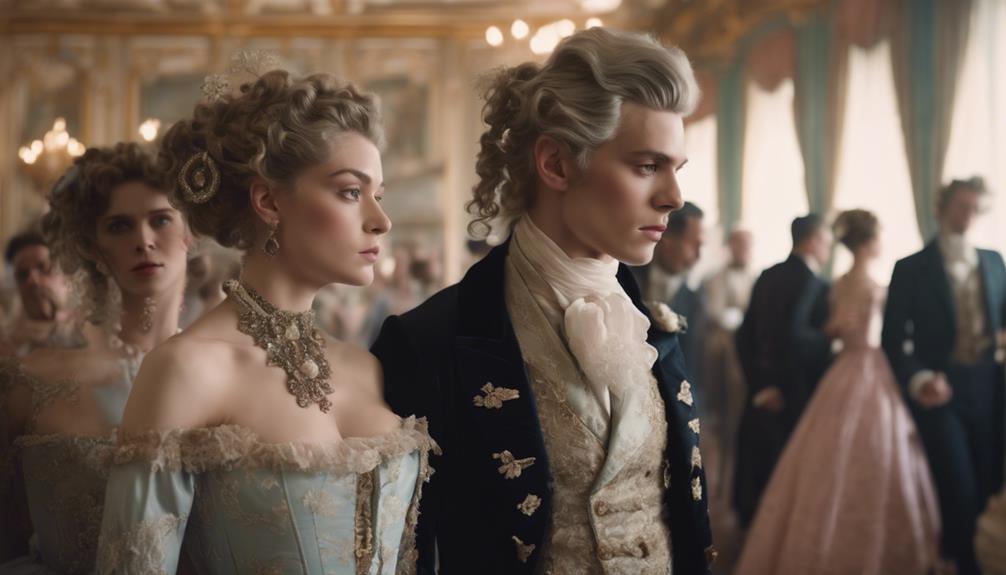
When you think about 17th-century fashion, you'll notice a few standout features.
Signature silhouettes and cuts defined the era, while luxurious silk and vibrant prints brought garments to life.
Plus, vintage cocktail dresses added a touch of elegance that continues to inspire today.
Signature Silhouettes and Cuts
In the 17th century, fashion showcased distinct silhouettes and cuts, with garments often emphasizing wide shoulders and fitted waists to create an hourglass figure.
As you explore the evolution of fashion, you'll notice how signature silhouettes have transformed over the centuries. The S-shaped silhouette of the early 1900s, for instance, highlighted a curvy figure, achieved through the use of corsets and structured undergarments.
During the 1920s, the trend shifted to the boyish silhouette with dropped waistlines and straight cuts, epitomized by the flapper dress.
The 1940s brought a dramatic change with Christian Dior's New Look, which featured nipped-in waists and full skirts, celebrating femininity post-war.
Fast forward to the 1960s, and you'll find the A-line silhouette, with fitted bodices that flared from the waist, creating a fresh, youthful look.
By the late 20th century, fashion embraced oversized cuts, reflecting a desire for comfort and individual expression, especially in the grunge and minimalist styles of the 1990s.
Each era's signature silhouettes tell a story of cultural shifts and personal identity, making fashion a fascinating lens through which to view history.
Luxurious Silk and Vibrant Prints
Luxurious silk and vibrant prints defined 17th-century fashion, showcasing the era's love for opulence and artistic expression in clothing. You can see how silk fabrics were highly prized for their sheen and softness, making them the go-to choice for elegant dresses and accessories. The vibrant prints you admire often drew inspiration from nature, featuring intricate patterns that celebrated the beauty of the world around you.
As textile production advanced, these luxurious materials became more accessible, allowing a wider audience to indulge in the elegance of silk. You'd notice that during this time, bold color contrasts became a hallmark of fashion, enhancing the visual appeal of garments.
The introduction of the crinoline underskirt also played a significant role; it amplified the beauty of printed silks, creating voluminous silhouettes that let intricate designs shine.
Moreover, technologies like the Jacquard loom revolutionized fabric production, allowing complex patterns to be woven directly into the silk. This innovation made it easier for you to find exquisite pieces that weren't only stunning but also a reflection of the craftsmanship of the era.
Vintage Cocktail Dresses
The elegance of vintage cocktail dresses, popular from the 1920s to the 1960s, showcases a refined femininity with their flattering silhouettes and knee-length hemlines.
These dresses often feature fitted bodices and flared skirts, enhancing your feminine silhouette for any occasion. Fabrics like silk, chiffon, and satin add a luxurious touch, while details such as beading, sequins, and lace elevate their timeless elegance.
The iconic little black dress, made famous by designers like Coco Chanel, emerged during this era, proving that versatility can coexist with sophistication.
Vintage cocktail dresses from the 1950s often sport voluminous petticoats and off-the-shoulder necklines, epitomizing the post-war celebration of glamour. You'll find unique design elements like sweetheart necklines, halter straps, and intricate embroidery that make these dresses perfect for special events or retro-themed parties.
When you slip into a vintage cocktail dress, you embrace a piece of history that brings charm and poise.
These timeless pieces aren't just clothing; they're statements of style, allowing you to embody the elegance of a bygone era while turning heads in the modern world.
Modern Interpretation
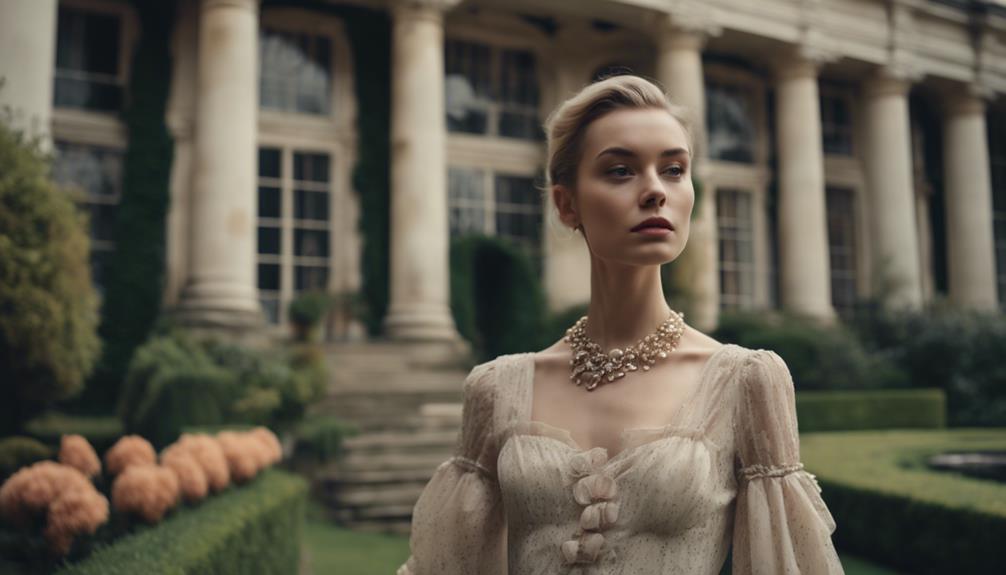
When you look at modern fashion, you'll notice how it draws from the past, including the elegance of 17th-century styles.
Sustainable innovations and iconic fashion houses keep these historical influences alive while adapting them for today's world.
Plus, fashion icons continue to reinterpret these classic elements, making them relevant and exciting for your wardrobe.
Sustainable Fashion Innovations
Embracing sustainable fashion innovations is vital for reducing environmental impact and promoting ethical practices in today's clothing industry. You'll find that brands are increasingly utilizing eco-friendly materials like organic cotton, recycled polyester, and Tencel, which considerably lower the environmental footprint compared to traditional fabrics.
Moreover, the adoption of circular fashion principles is gaining traction. This encourages recycling and upcycling of garments, allowing you to extend their lifecycle and minimize textile waste in landfills. Technological advancements like 3D knitting and digital printing also play an essential role, enabling brands to produce custom pieces with minimal waste, fostering a more sustainable production process.
As you explore the market, you'll notice the rise of rental and resale platforms, transforming consumer behavior towards a sharing economy. This shift emphasizes sustainability by reducing the demand for new clothing.
Additionally, many sustainable fashion brands implement transparent supply chains, ensuring ethical labor practices and responsible sourcing. This resonates with you as a conscious consumer, allowing you to support environmentally and socially responsible businesses while making a positive impact.
Iconic Fashion Houses Today
How do iconic fashion houses today blend classic styles with modern trends to create a unique identity that resonates with you? These fashion houses, like Chanel and Dior, expertly reinterpret iconic styles while incorporating elements of modern fashion. They embrace sustainable practices, ensuring that their influence extends beyond aesthetics to include environmental responsibility.
Gucci, under Alessandro Michele, has revitalized its image by combining vintage aesthetics with contemporary maximalism, attracting a younger audience enthusiastic for bold statements. Meanwhile, Balenciaga pushes the boundaries of traditional fashion norms with avant-garde designs and deconstructed silhouettes that challenge your perception of style.
The resurgence of brands like Valentino and Fendi showcases a vibrant mix of bold colors and intricate craftsmanship, merging streetwear with high fashion. This fusion speaks to today's consumers, who crave authenticity and creativity in their wardrobes.
Moreover, collaborations with artists and influencers create limited-edition collections that bridge the gap between classic luxury and modern pop culture. This approach allows you to experience fashion that feels both timeless and relevant, making iconic styles accessible in today's ever-evolving landscape.
Fashion Icons of the Era
Fashion icons of the era have redefined style by blending bold creativity with personal expression, making their influence resonate deeply with contemporary audiences.
Think about Coco Chanel, who popularized the little black dress—a timeless piece that symbolizes elegance and simplicity. This staple continues to empower modern women, allowing them to express their individuality effortlessly.
Audrey Hepburn's chic style, especially seen in 'Breakfast at Tiffany's,' showcases how fashion can narrate a story while embodying sophistication. Her looks inspire countless women today, proving that classic styles can be modernized and personalized.
Then there's David Bowie, who shattered traditional gender norms with his androgynous flair as Ziggy Stardust. His daring approach to fashion paved the way for embracing diversity in fashion, encouraging everyone to explore their identity through clothing.
Styling Tips
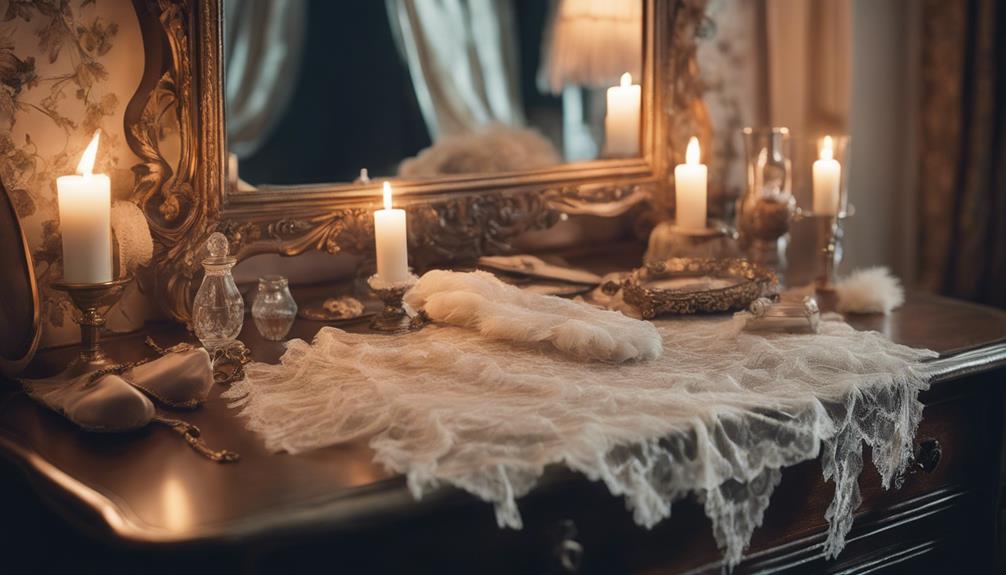
When you want to embody 17th-century elegance, start with a classic little black dress that serves as a versatile foundation.
Pair it with vintage accessories to enhance your look and create a cohesive style that nods to the past.
Don't shy away from layering textures and patterns, as this adds depth and visual interest to your outfit.
Classic Little Black Dress
The Classic Little Black Dress is a versatile piece that can be transformed for any occasion with the right styling choices. Originating from Coco Chanel's vision in the 1920s, this timeless quality garment symbolizes modern femininity and adaptability. To nail your look, consider the occasion and your personal style.
For a casual outing, pair your little black dress with a denim jacket and stylish sneakers. This effortlessly chic ensemble balances comfort and flair. If you're heading to a formal event, elevate your LBD with elegant heels and statement jewelry. Opt for fabrics like silk or satin to enhance the dress's appeal, making it suitable for upscale gatherings.
Don't shy away from experimenting with different cuts and lengths that flatter your body type. A fitted silhouette can accentuate your shape, while an A-line design offers a relaxed vibe. Accessories play an essential role in transforming your outfit; try a bold handbag or colorful shoes to inject personality.
Embrace the versatility of the little black dress, and let it become your go-to choice for any occasion, proving that timeless fashion can adapt to your unique style.
Vintage Accessories Pairing Tips
Pairing vintage accessories can elevate your outfit, adding unique character and a touch of history to your modern wardrobe. To create a cohesive look, consider the era of your outfit. For instance, if you're wearing a 1920s flapper dress, match it with a beaded clutch and a cloche hat for that authentic vibe.
Don't shy away from layering vintage brooches or pins on a simple blouse or jacket; this adds character and allows you to showcase styles from various decades. Vintage scarves are another versatile option—they can be worn around your neck, tied in your hair, or attached to a vintage handbag, bringing a pop of color and pattern to any outfit.
If your outfit is minimalist, choose statement earrings from the 1980s, like oversized hoops or bright geometric shapes, to make a bold statement. For a timeless look, vintage handbags such as classic leather satchels or structured box bags bridge the gap between old and new styles, perfectly complementing your modern attire.
Embrace these tips, and you'll effortlessly blend vintage charm with contemporary flair!
Layered Textures and Patterns
Embrace the art of layering textures and patterns to create visually striking outfits that reflect your unique style. Start by mixing layered textures like silk, chiffon, and lace to add depth to your ensemble.
Don't be afraid to combine various patterns, such as florals with stripes or polka dots, to channel that bold, maximalist aesthetic reminiscent of the 1960s and 1970s.
When styling, think about contrasting textures—pair a soft cashmere sweater with a structured leather skirt for an edgy yet feminine look. This contrast not only enhances visual interest but also makes your outfit feel more dynamic.
Additionally, consider using accessories like vests, shawls, or oversized belts to elevate your layered textures and add dimension.
Color blocking is another fantastic technique to explore. By strategically choosing colors, you can create a cohesive look even when mixing different textures and patterns.
Experimenting with different combinations will help you find your signature style. Remember, layering is all about creativity, so let your personality shine through your outfits!
Shopping Guide
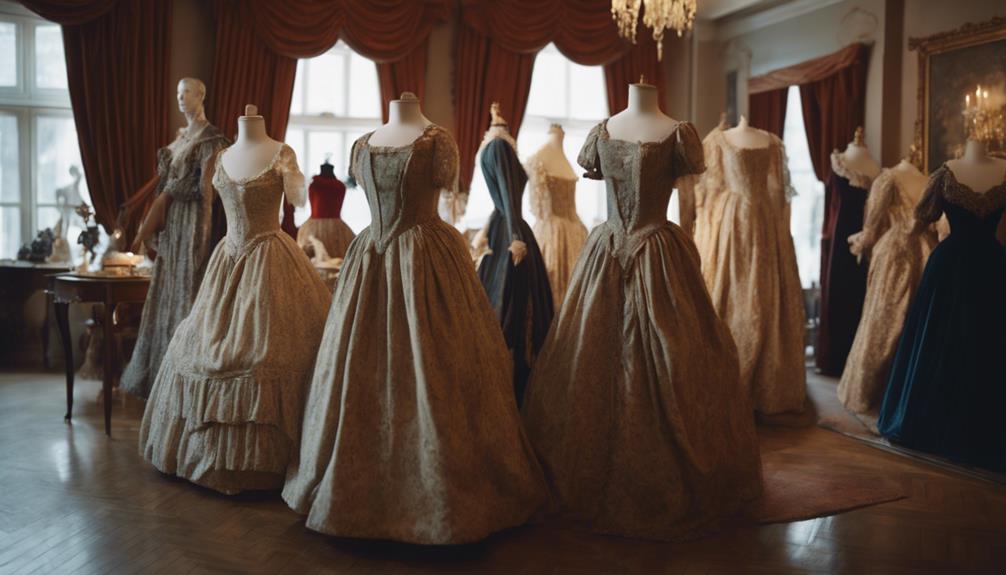
When you're on the hunt for 20th-century fashion pieces, focus on specific decades to uncover the unique styles that define each era. Whether you're drawn to flapper dresses of the 1920s or the power suits of the 1980s, pinpointing a decade can help streamline your search.
Start exploring vintage boutiques, online marketplaces, and estate sales. These places often feature period-specific clothing and accessories, giving you a chance to find authentic items at various price points.
Familiarizing yourself with fabric types like rayon and silk, especially from the 1940s, will help you assess garment quality.
Keep an eye out for iconic designers such as Christian Dior and Coco Chanel, whose pieces aren't only fashionable but also valuable to collectors. Their timeless creations can elevate any wardrobe.
Additionally, don't underestimate the power of accessories. Cloche hats from the 1920s or bold statement jewelry from the 1980s can enhance your look and add a historical touch.
Upcycled Vintage Fashion Projects
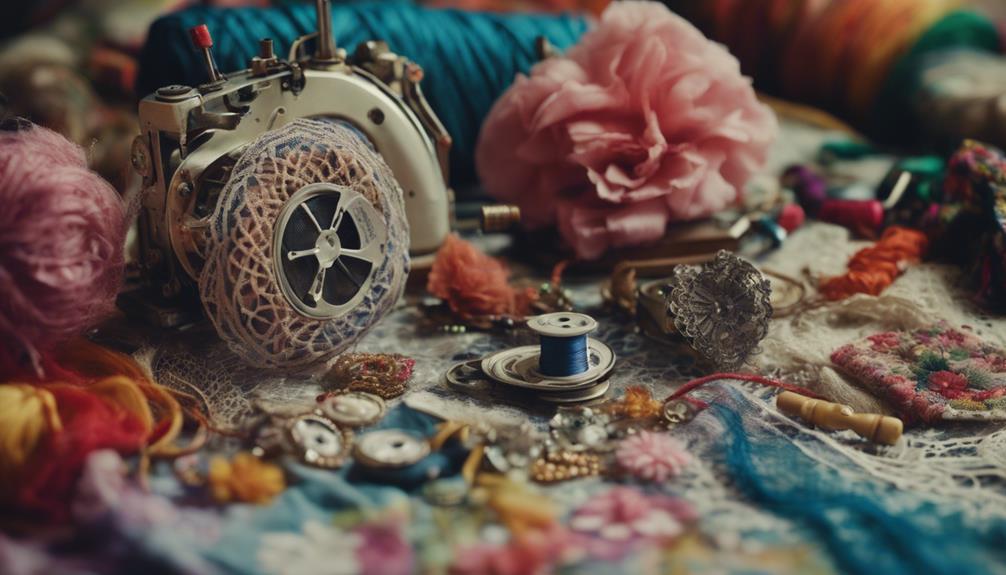
You can easily transform vintage pieces into stunning new outfits with upcycled fashion projects.
By using simple DIY embellishment techniques, you can add your personal touch and create unique items that stand out.
Let's explore some inspiring ideas that will spark your creativity and help you embrace sustainable fashion.
Upcycled Fashion Project Inspirations
Often, transforming vintage garments into upcycled fashion pieces sparks creativity and promotes sustainability in your wardrobe. You can experiment with various techniques to breathe new life into outdated clothing while reducing textile waste.
Consider dyeing a 1970s polyester dress in a fresh hue or creating a patchwork design from multiple pieces of 1980s denim. These methods not only showcase your personal expression but also align with the growing trend of sustainable fashion.
As you embark on upcycled fashion projects, think about how these vintage materials can be repurposed into contemporary styles. This cyclical nature of fashion honors historical aesthetics while allowing you to create something uniquely yours.
You'll find that many consumers are actively seeking sustainable options, making your upcycled creations even more relevant.
DIY Embellishment Techniques
Exploring DIY embellishment techniques can transform vintage garments into standout fashion pieces that reflect your unique style and commitment to sustainability. Upcycling vintage fashion not only breathes new life into old clothing but also helps reduce waste. Start with simple methods like adding embellishments—think beads, sequins, or rhinestones—to elevate a basic piece into something eye-catching.
Embroidery is another fantastic option, allowing you to personalize your garments while showcasing your creativity. You can also sew on patches to cover up wear and tear while adding a trendy twist.
If you're looking for a more dramatic change, fabric paint or dye can refresh the color of worn-out items, giving them a modern vibe. For denim, consider techniques like tie-dye or distressing to align your pieces with current fashion trends while honoring their history.
Each of these DIY embellishment techniques enables you to create distinctive fashions that not only stand out but also tell a story. So, gather your materials and let your imagination run wild—your next favorite outfit is just a project away!
Cultural Impact
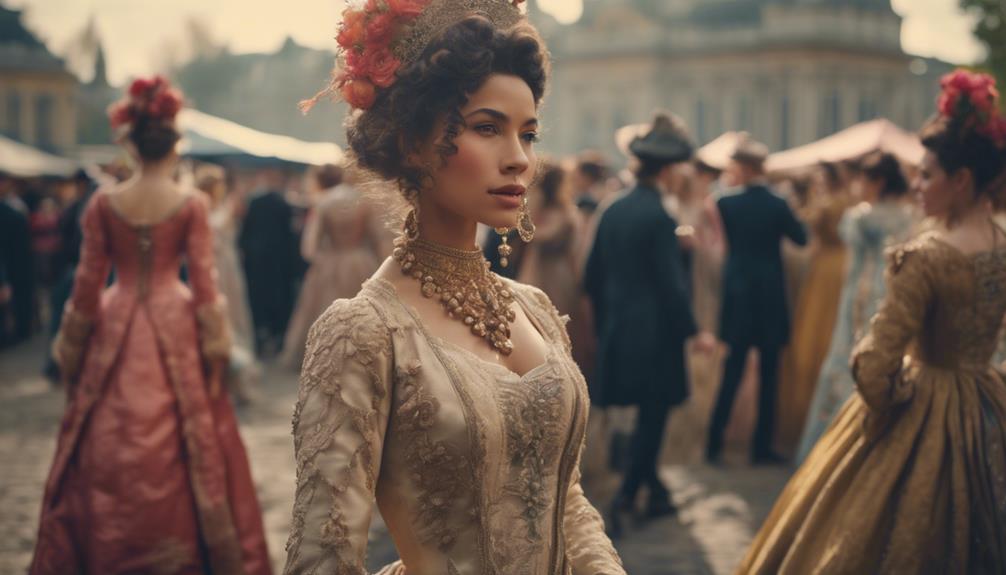
When you look at 17th-century fashion, you can't ignore its cultural impact on film and music. The dramatic styles of the time often inspired modern portrayals of historical figures, influencing how we perceive that era in popular culture.
Counterculture fashion trends also emerged, showcasing how people used clothing to challenge societal norms and express individuality.
Fashion in Film and Music
Fashion in film and music has profoundly shaped cultural trends, influencing how we express ourselves and perceive style in everyday life.
Iconic films like 'Breakfast at Tiffany's' introduced you to timeless pieces, such as Audrey Hepburn's little black dress, which continues to inspire contemporary fashion choices. The music industry plays a vital role, too; artists like David Bowie have challenged traditional gender norms with androgynous styles, leaving a lasting impact on your wardrobe.
The 1980s saw the rise of music videos, allowing you to visually connect with fashion trends. Stars like Madonna popularized bold, extravagant looks that permeated mainstream culture and encouraged you to take risks with your style.
You can't overlook the Bohemian style, which emerged in the 1960s, emphasizing free-spirited clothing and vibrant patterns. This aesthetic resonated with the hippie movement and has since become a staple in everyday fashion.
Today, films and music continue to serve as platforms for fashion innovation. Collaborations between contemporary artists and designers reflect current societal values and aesthetics, ensuring fashion remains dynamic and relevant to your life.
Counterculture Fashion Trends
Counterculture fashion trends have markedly influenced societal views on identity and self-expression, challenging conventional styles and sparking important cultural conversations.
In the 1960s and 1970s, movements like the Civil Rights Movement and Women's Liberation inspired you to embrace individuality through fashion. The hippie style emerged, with its vibrant colors, tie-dye patterns, and flowing garments symbolizing a rebellion against mainstream values, promoting peace and a return to nature.
In the mid-1970s, punk fashion took center stage, utilizing DIY aesthetics with ripped clothing, leather jackets, and graphic tees. This style served as a visual protest against the establishment, encouraging you to express your discontent with societal norms.
At the same time, the 'Black is Beautiful' movement celebrated African heritage, leading you to explore traditional styles, natural hair, and bold prints as symbols of pride and identity.
Even as grunge fashion emerged in the 1990s, influenced by music icons like Nirvana, it reflected a rejection of consumerism with oversized flannel shirts and combat boots.
These counterculture fashion movements have reshaped how you view identity, encouraging authentic self-expression and cultural pride.
Frequently Asked Questions
What Fashion Style Is Timeless?
Timeless fashion styles include the little black dress, tailored suits, and vintage denim. You'll find that these pieces effortlessly blend comfort and elegance, making them essential staples in your wardrobe that never go out of style.
What Are the Fashion Eras in Order?
To understand fashion eras in order, start with the 1900s S-shape silhouette, then move to the 1910s' natural styles, the 1920s' flappers, 1940s' wartime practicality, and finally, the 1960s' vibrant mod culture.
What Are the Eras of Vintage Fashion?
When you explore vintage fashion, you'll encounter distinct eras: the Roaring Twenties with flappers, glamorous Thirties influenced by Hollywood, practical Forties, revolutionary Fifties, and bold Sixties that embraced youth culture and vibrant styles.
What Type of Clothing Was Popular in the 1970s?
In the 1970s, you'd see flowing maxi dresses, bell-bottom jeans, and vibrant disco outfits. Icons like David Bowie inspired androgynous looks, while punk fashion challenged norms with leather jackets and ripped jeans. Fashion was bold and diverse!
Are the Fashion Styles from the 1880s Inspired by the 17th Century?
Fashion styles from the 1880s were indeed inspired by the 17th century, with elements such as corsets, high collars, and voluminous skirts reminiscent of the earlier era. These timeless 1880s fashion styles reflected a romanticized view of the past, combining historical influences with the aesthetics of the Victorian era.
Conclusion
In exploring 17th-century fashion, you've uncovered timeless styles that continue to inspire today.
By understanding the origins and key characteristics, you can easily incorporate these elements into your wardrobe.
Whether you're experimenting with modern interpretations or diving into upcycled vintage projects, there's a wealth of creativity waiting for you.
So, embrace the elegance of the past and let it influence your personal style—after all, fashion is all about expressing who you are!
